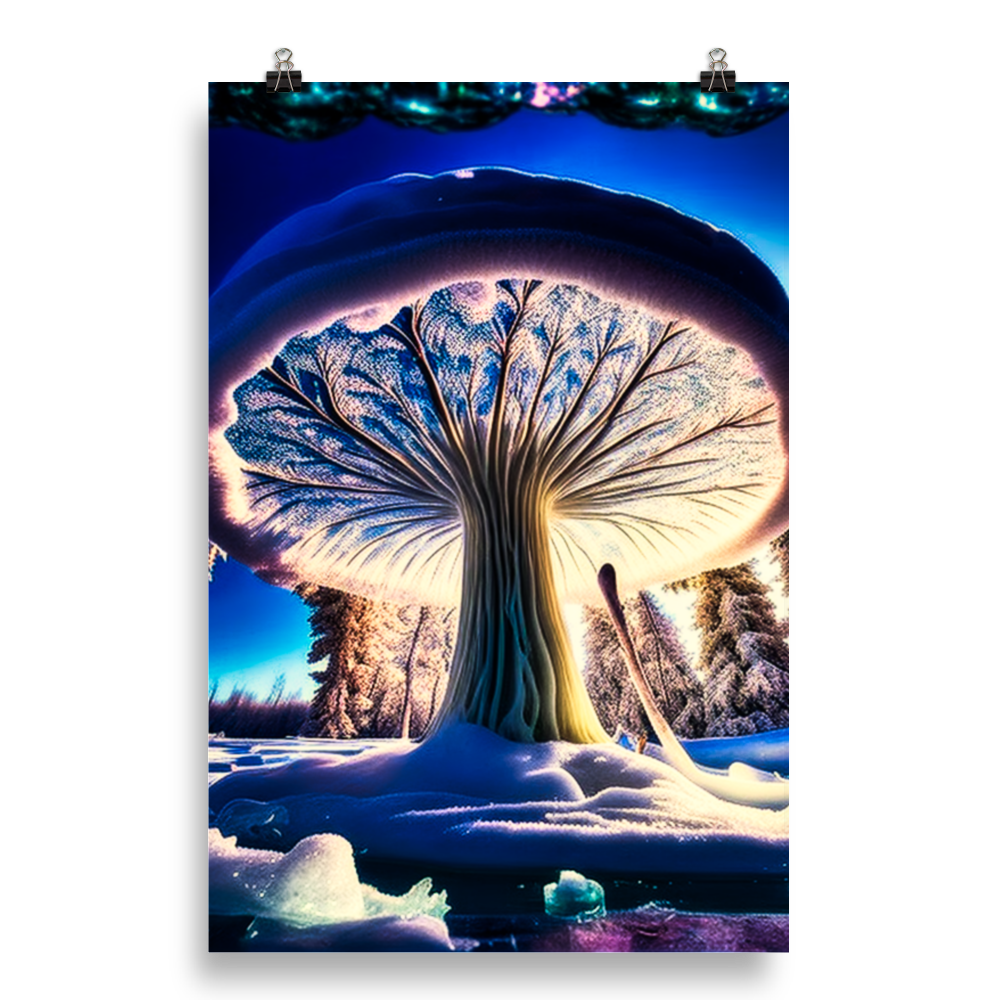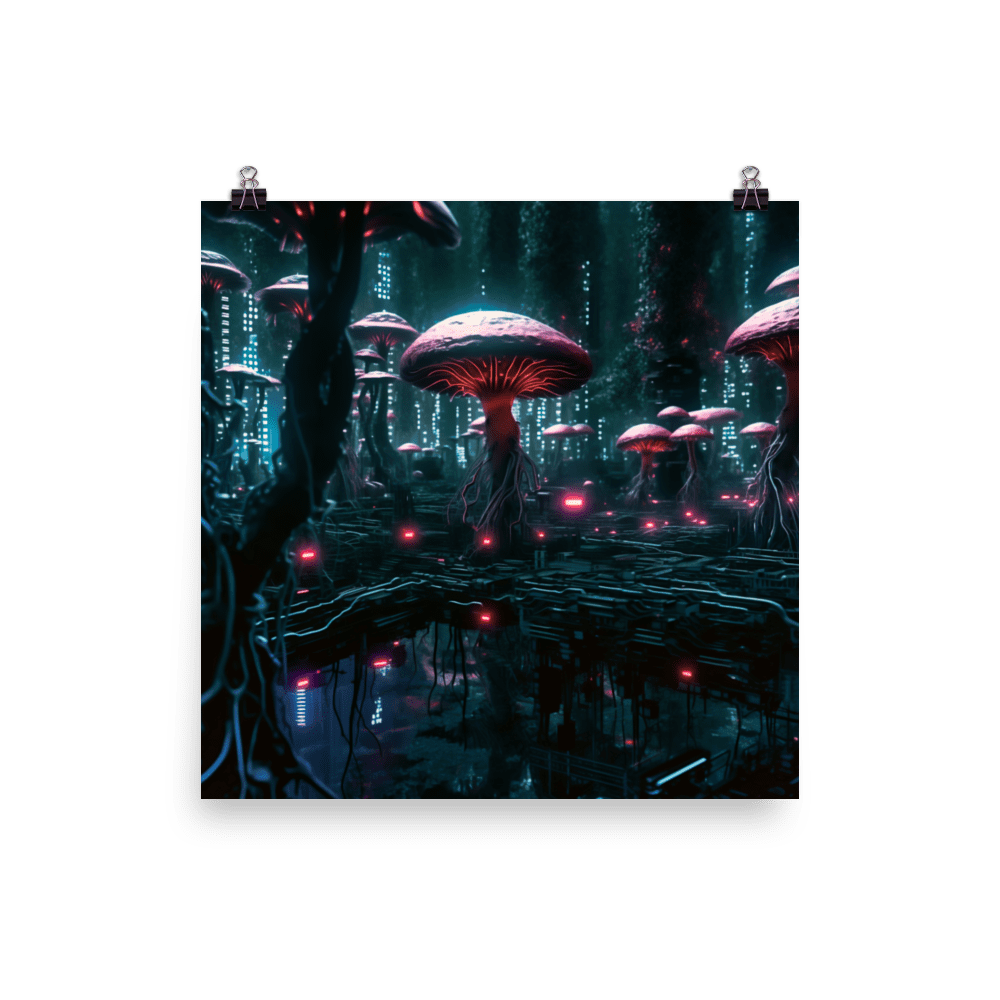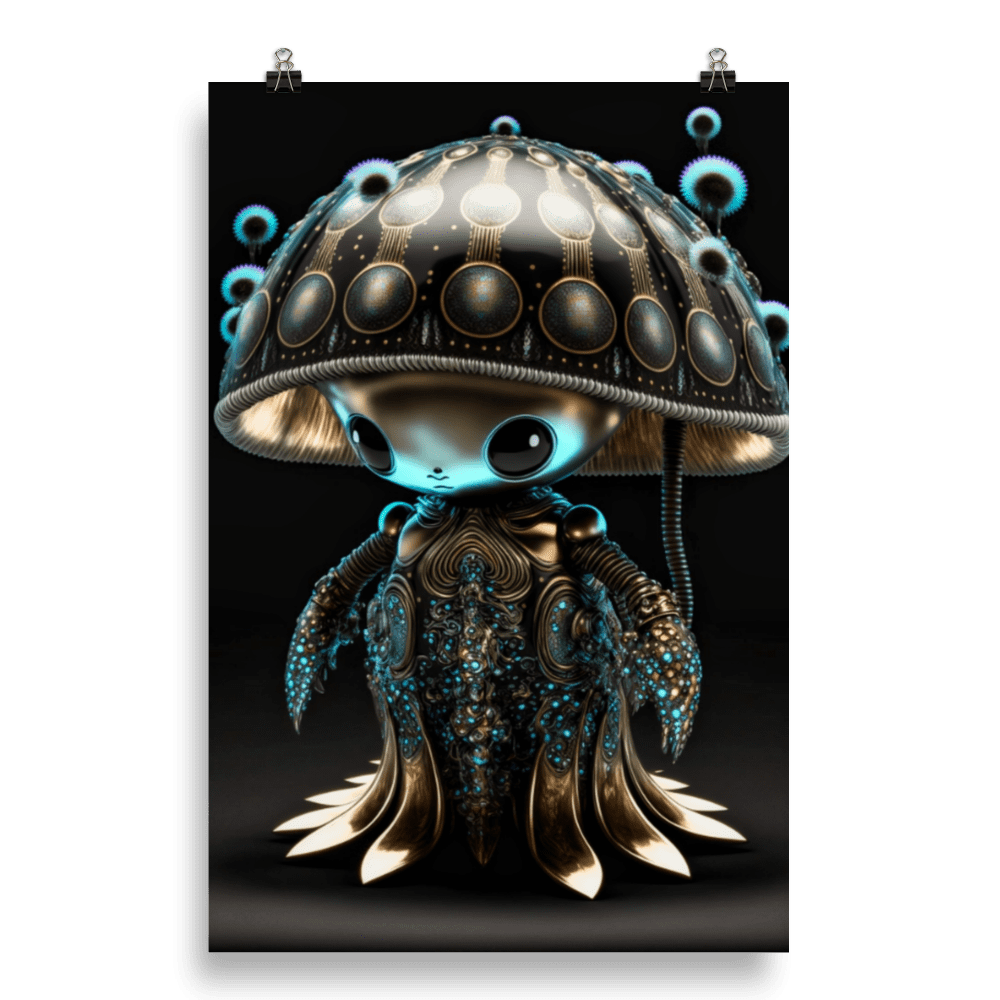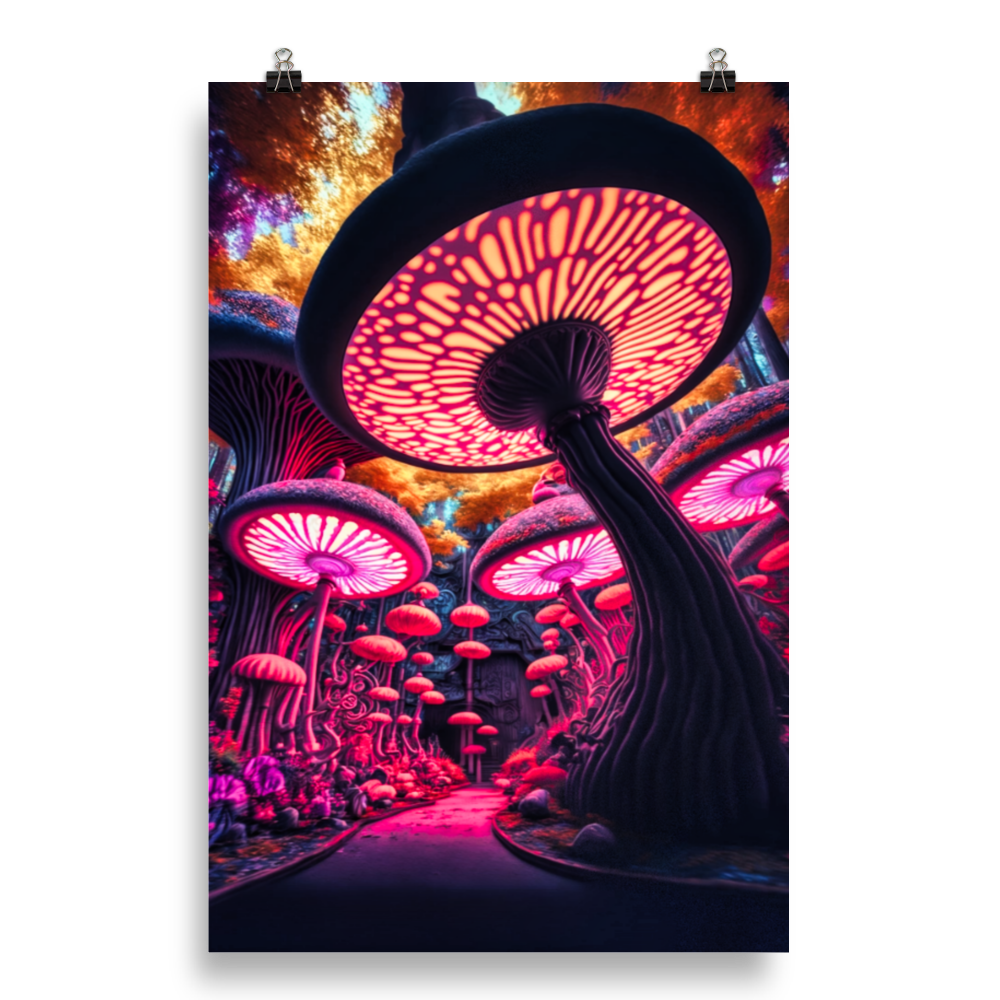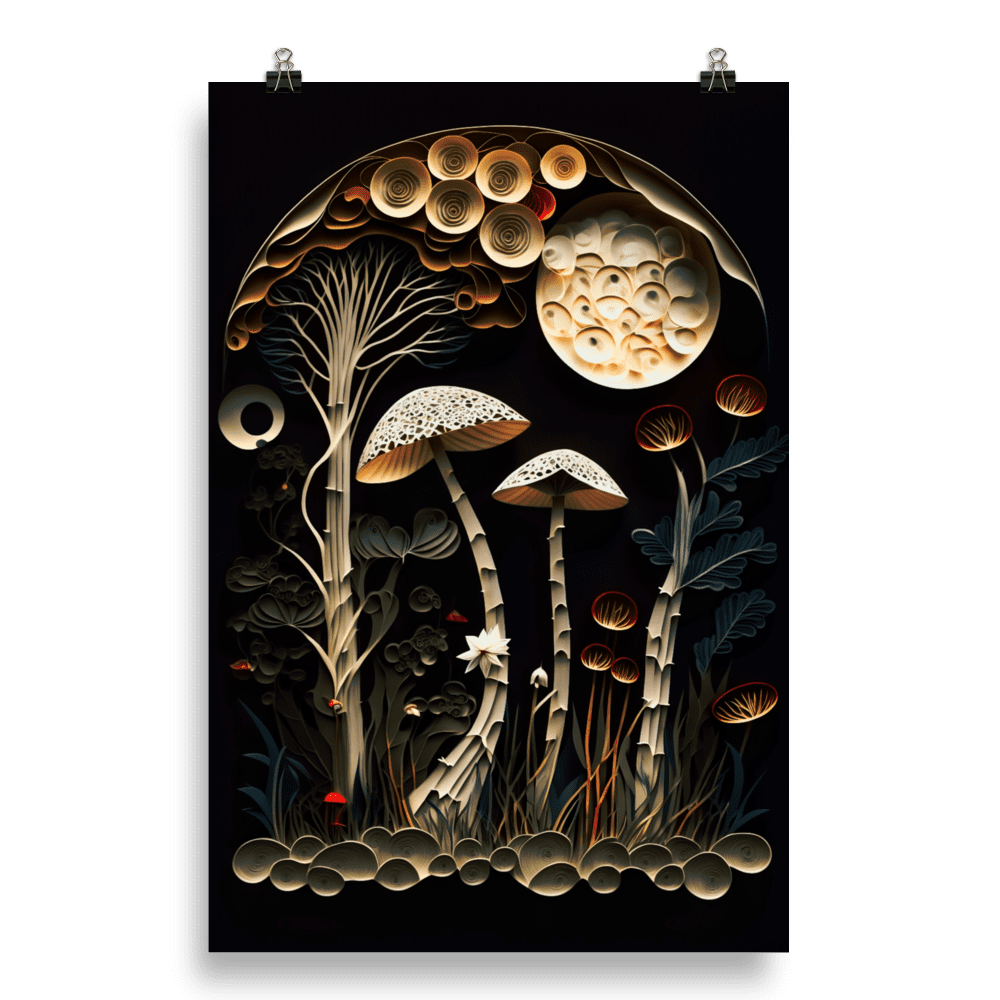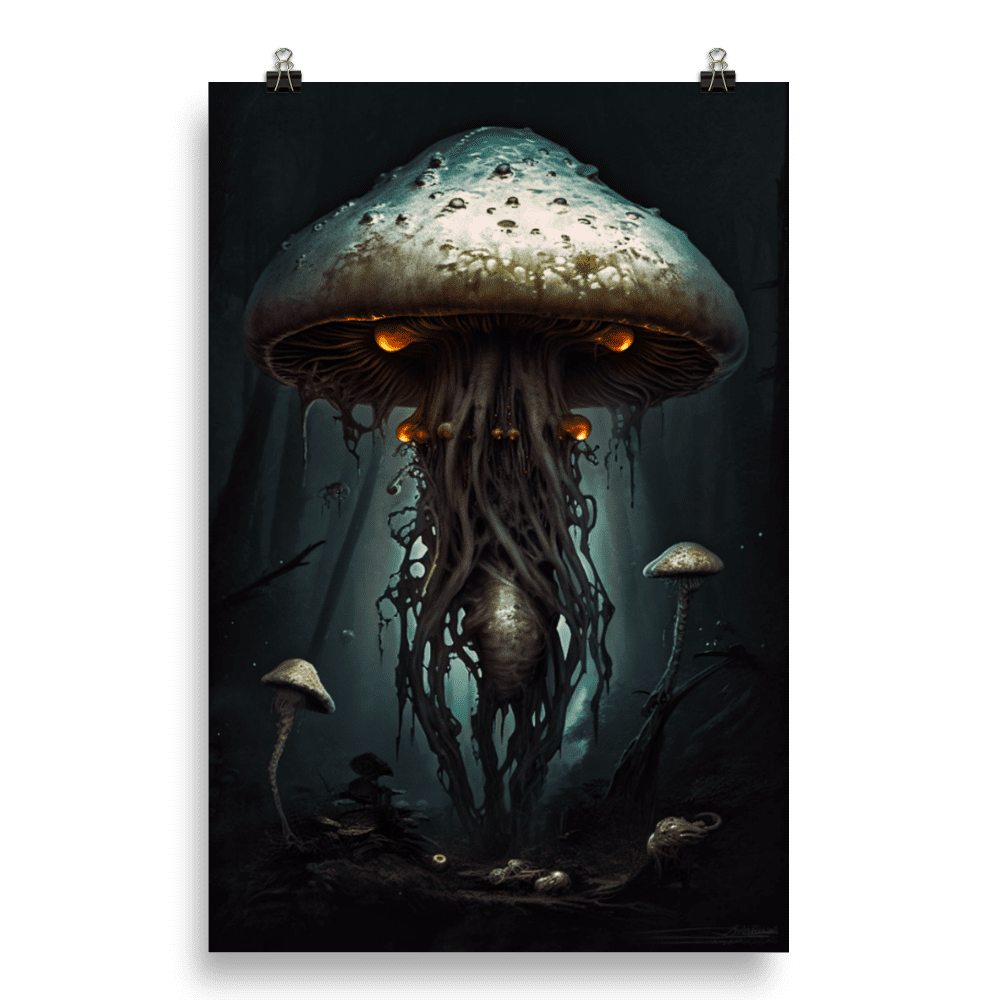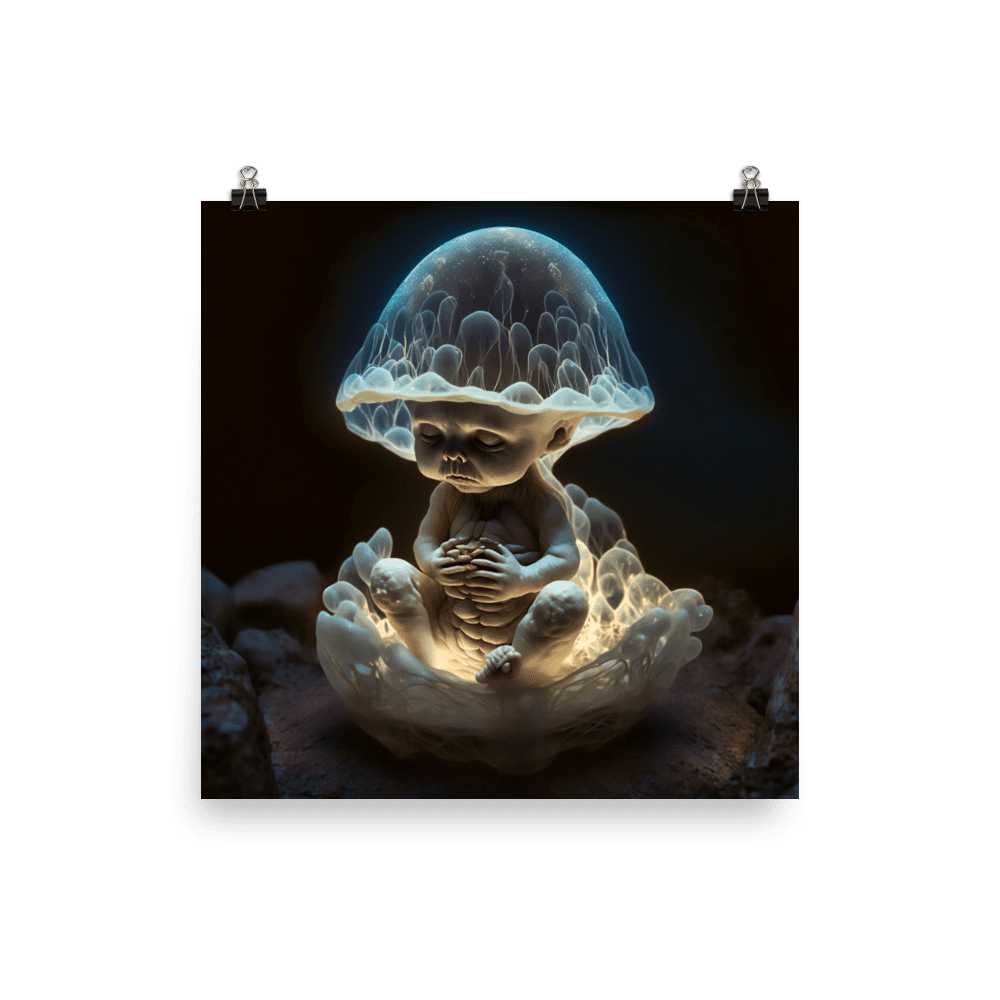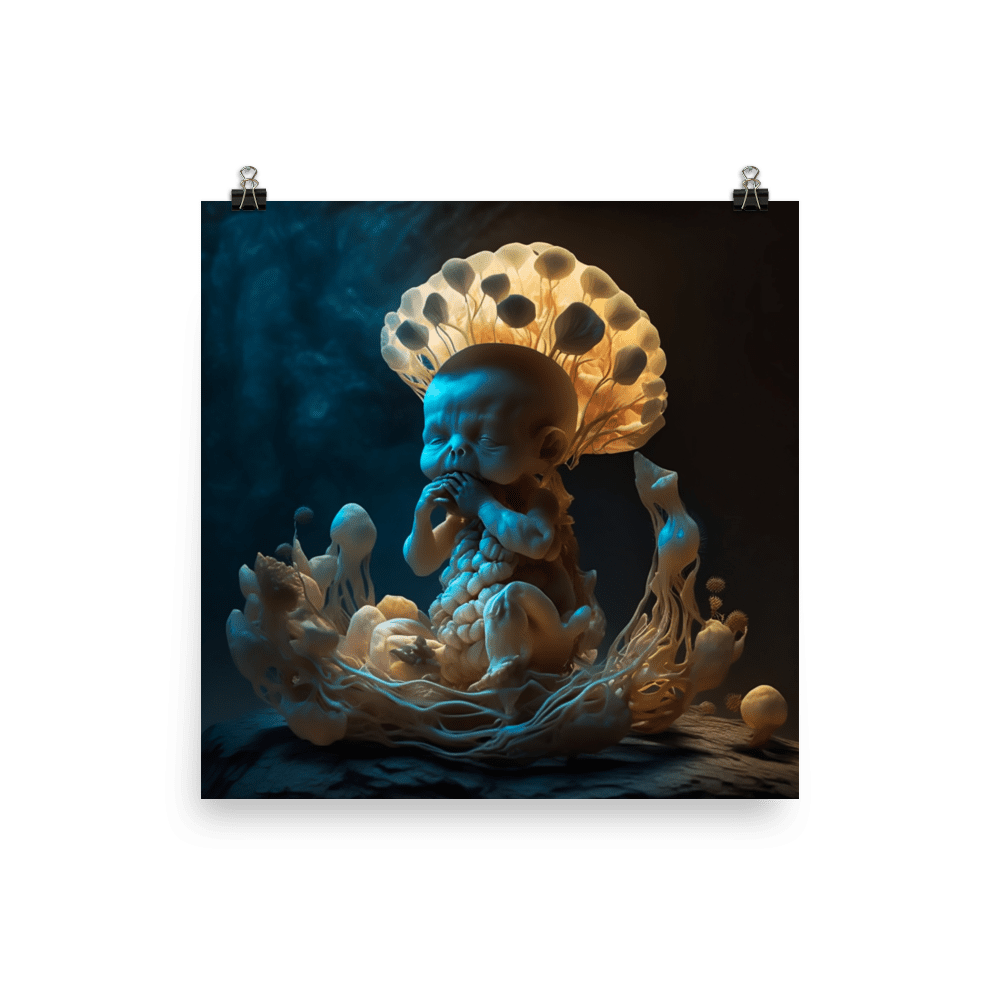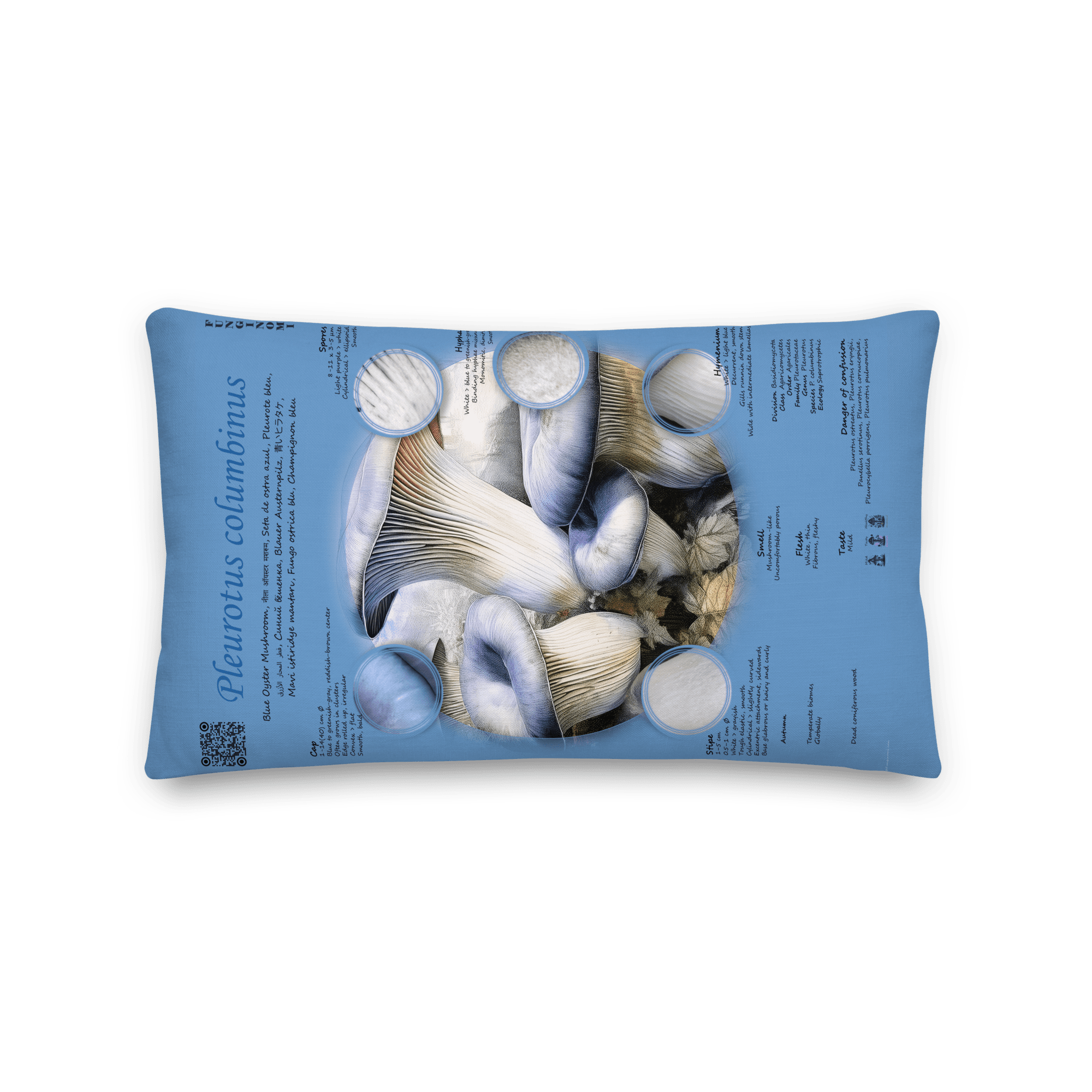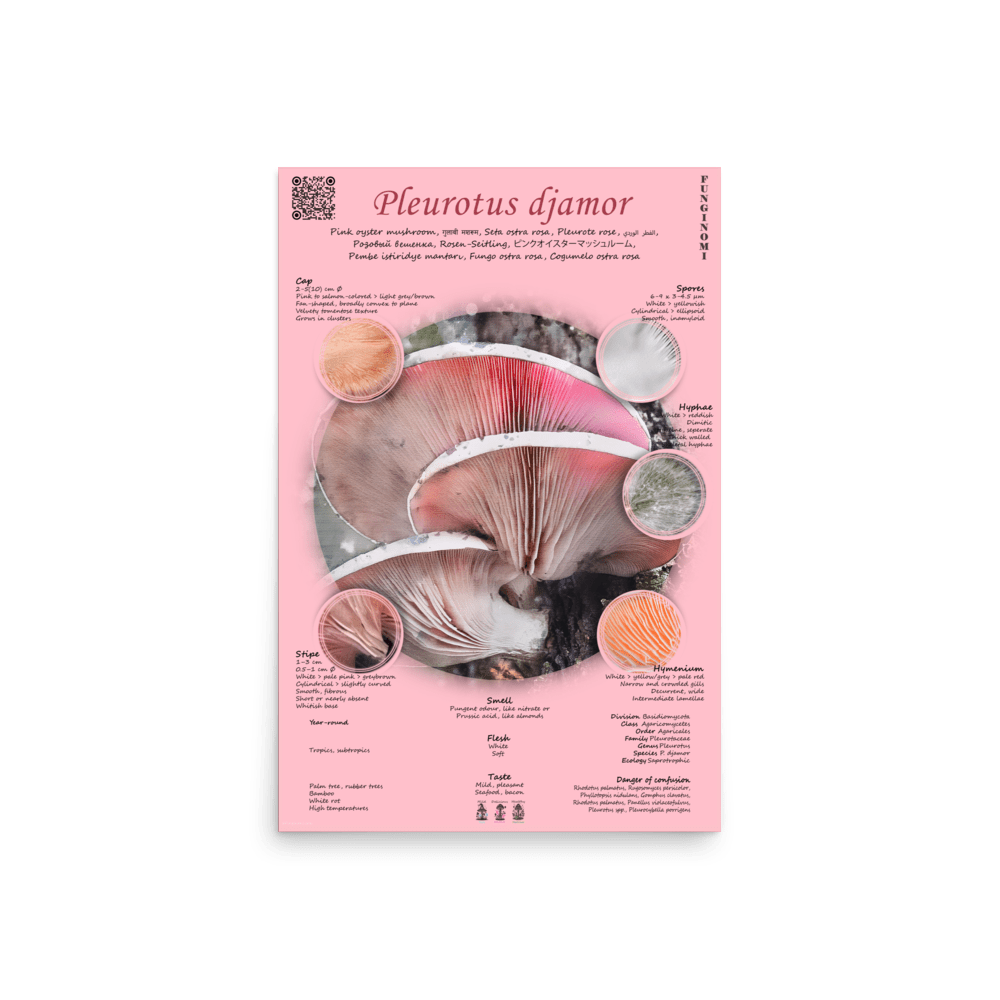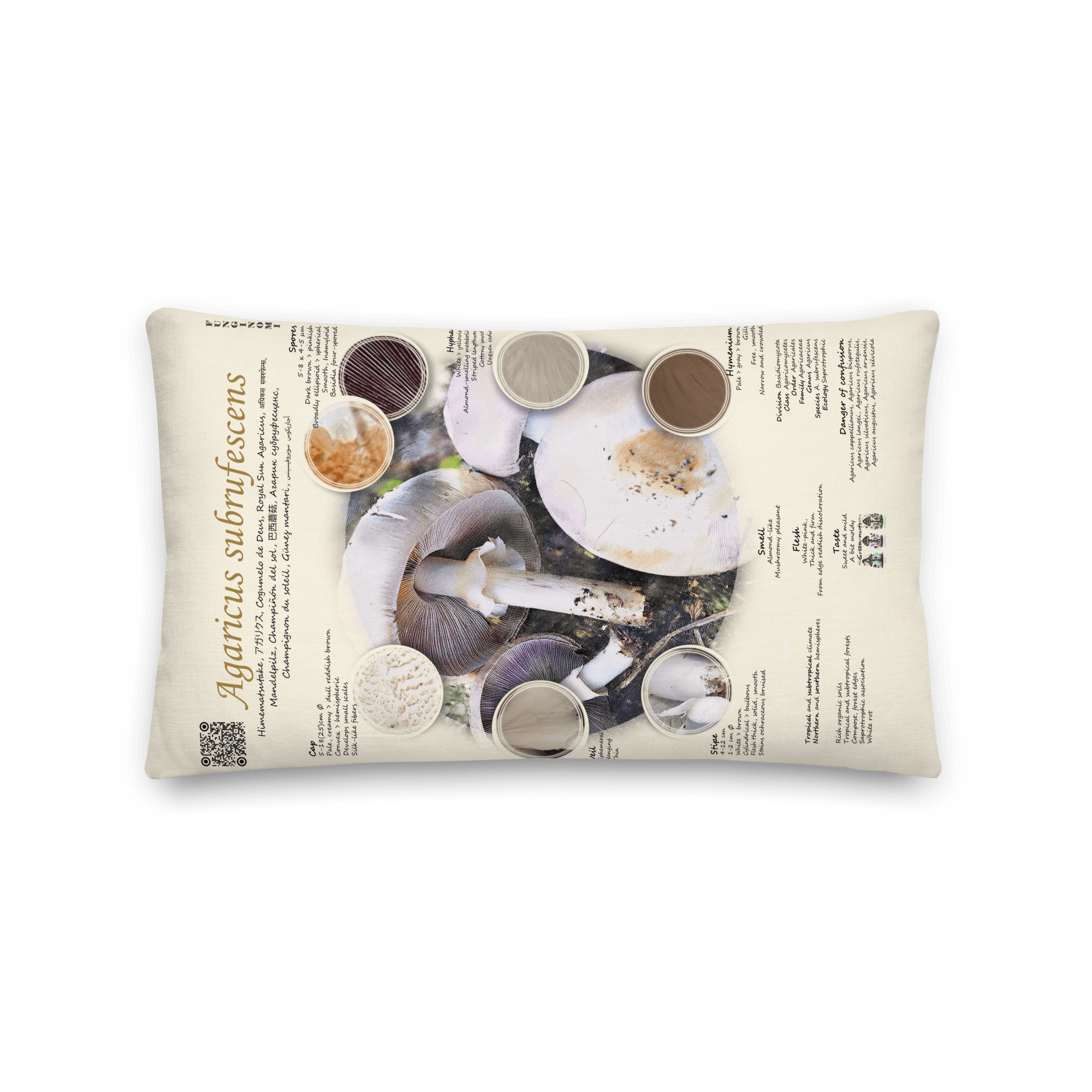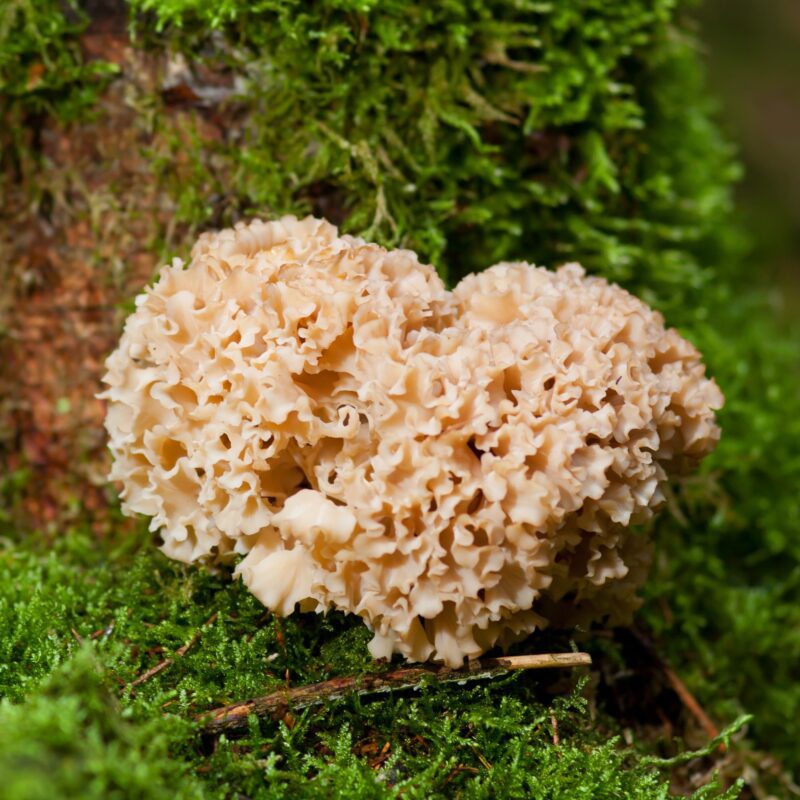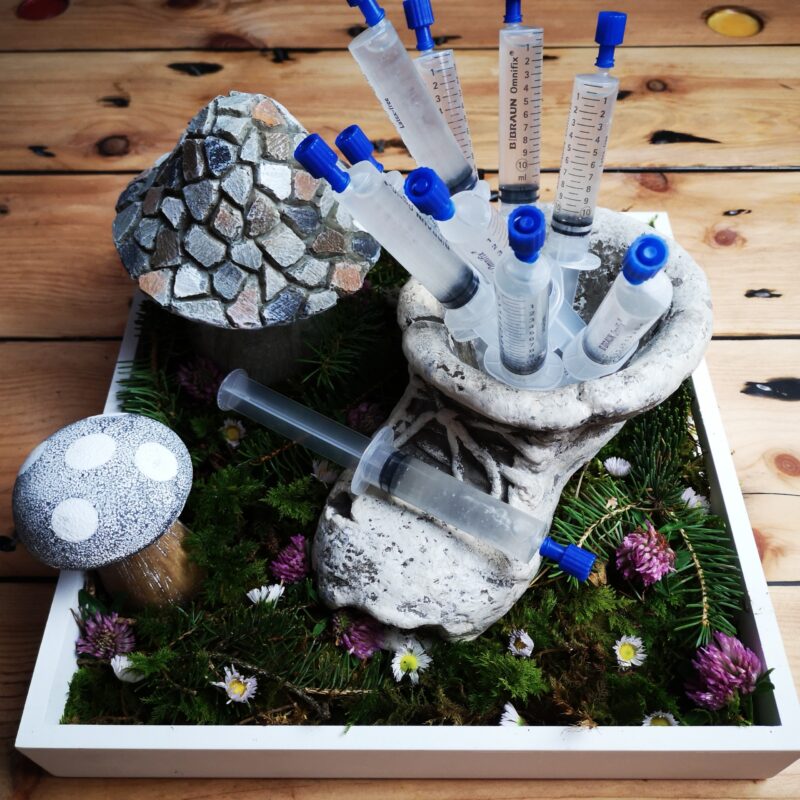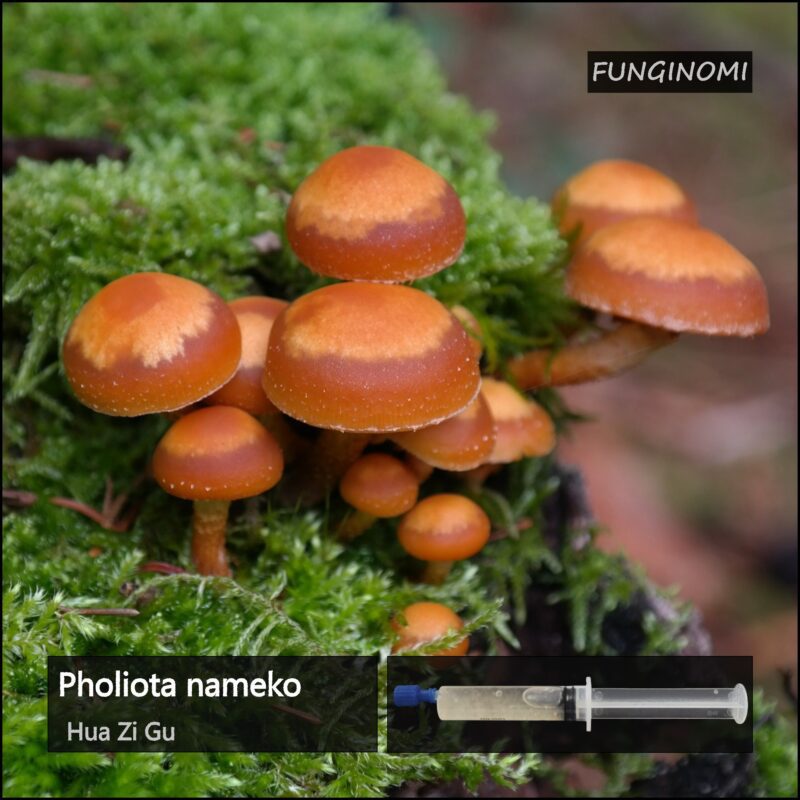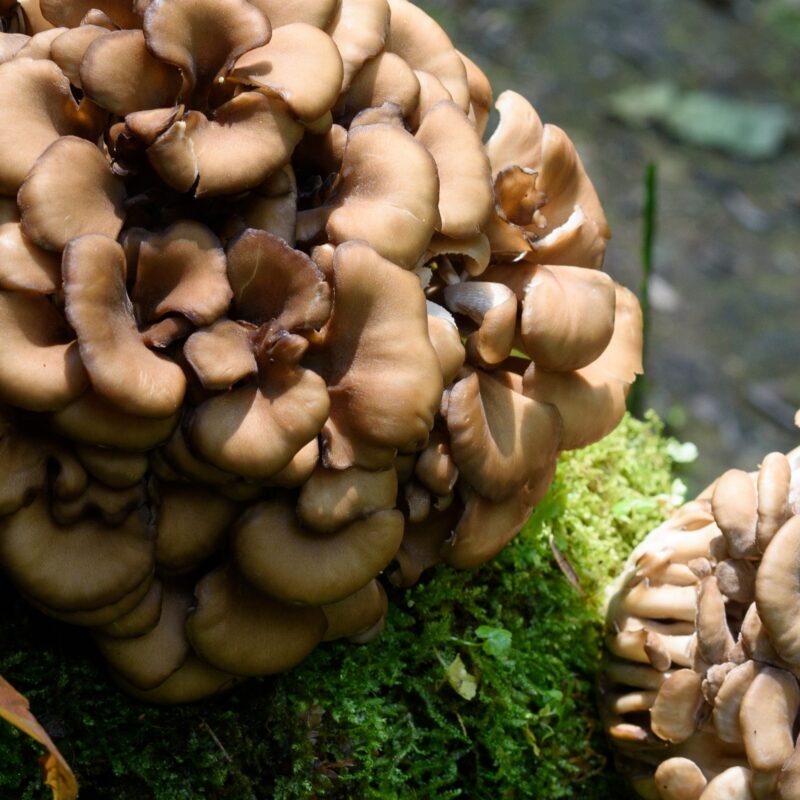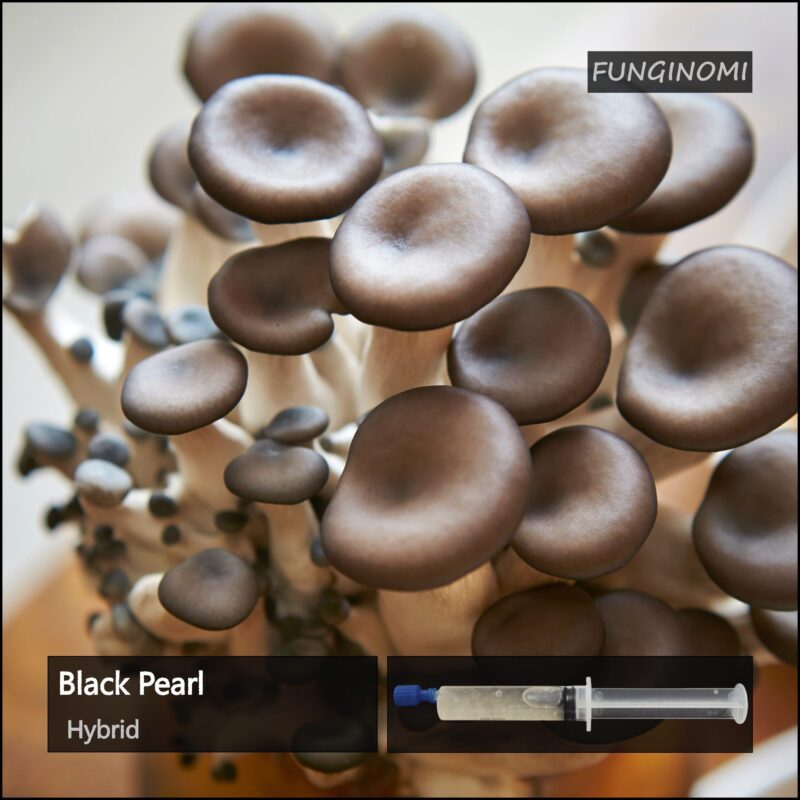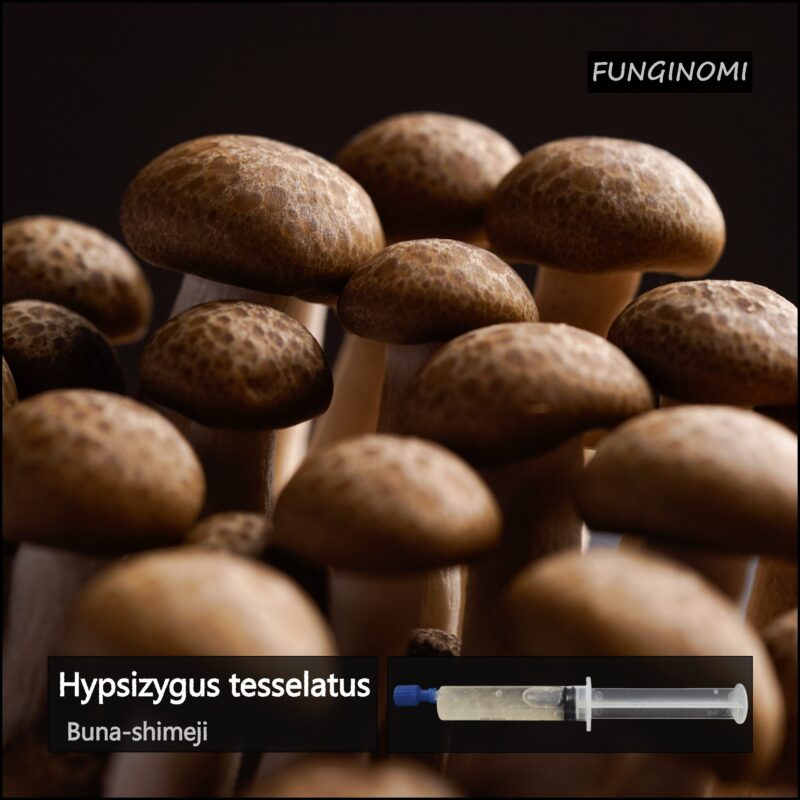Pleurotus djamor
Description
The Pink Oyster Mushroom (Pleurotus djamor, syn. P. salmoneostramineus is a leaf fungus from the sallow family. It colonizes injured or dead wood and produces pink fruiting bodies that are popular as edible mushrooms, especially in East Asia.
P. djaomor does not tolerate permanent temperatures below 8°C at any stage of growth. Therefore, never store cultures of this mushroom in the refrigerator.

You will hardly find a better beginner mushroom, Pink Oyster Mushrooms are very forgiving and despite their flowery appearance extremely aggressive. They conquer substrates of all kinds very quickly and fruit immediately, sometimes even before the substrate has been fully broken down.
With its aroma reminiscent of bacon or salmon ham, the rose mushroom is considered an exquisite edible mushroom and is cultivated primarily in Asia. Especially in Japan, the cultivation of this mushroom has a long tradition, using tree stumps and wooden beams as substrate. Suitable growing media include sawdust from copper beech, willow, poplar, or alder.
Collection August 2024
Grab them, they are hot! 😊
Properties
Pleurotus djamor naturally synthesize a chemical called lovastatin. Lovastatin is part of the statin family of drugs, meaning that it inhibits the production of cholesterol in the body and can potentially lower LDL cholesterol. Lovastatin can also be found naturally in Red Yeast Rice and is manufactured commercially from Aspergillus terreus.
Lovastatin works by inhibiting the activity of the enzyme HMG-CoA reductase, which acts as the rate limiting step to the synthesis of cholesterol in the body. This serves to help prevent hypercholesterolemia, or high cholesterol, which is a major risk factor in cardiovascular disease. Studies in rats support the cholesterol lowering effects of ingesting Pleurotus ostreatus, which naturally contains about 2.8% Lovastatin by weight.
HMG-CoA reductase serves as the rate limiting enzyme for cholesterol productionThe conversion of HMG-CoA to mevalonate by HMG-CoA reductase is blocked by Lovastatin.
Oyster mushrooms are an excellent source of nutrients, and are a low calorie, low cholesterol, and low fat source of protein, dietary fiber, thiamin, vitamin B6, iron, magnesium, zinc, manganese, niacin, copper, potassium, and antioxidants. Check out these impressive nutrition facts.
It has likely similar medicinal properties to Pleurotus ostreatus
Growing
How to Grow Pleurotsu djamor?
Materials Needed
- Pink oyster mushroom spawn
- Substrate (sawdust, straw, newspaper shavings, or rolls of toilet paper)
- Large plastic bags or containers
- Sterilized water
- Spray bottle
- Hygrometer
- Thermometer
Step-by-Step Instructions
Step 1: Prepare the Substrate
Choose Substrate: Select a suitable substrate such as sawdust, straw, newspaper shavings, or rolls of toilet paper. Pink oyster mushrooms are not picky and can grow on various organic materials.
Sterilize Substrate: Pasteurize or sterilize the substrate to kill any competing organisms. For straw or sawdust, you can soak it in hot water (160-180°F) for about an hour. For newspaper shavings or toilet paper, you can use boiling water.
Drain and Cool: Allow the substrate to cool and drain excess water. The substrate should be moist but not dripping.
Step 2: Inoculate the Substrate
Mix Spawn with Substrate: Once the substrate is cool, mix in the mushroom spawn. Use a ratio of about 5-10% spawn to the total weight of the substrate.
Pack into Containers: Fill large plastic bags or containers with the inoculated substrate. Pack it down lightly to remove air pockets.
Step 3: Incubation (Spawn Run)
Seal and Store: Seal the bags or containers loosely to allow for some air exchange. Store them in a dark, warm place with temperatures between 75-86°F (24-30°C).
Monitor: Check the substrate regularly for signs of mycelium growth, which looks like white, fluffy threads spreading throughout the substrate. The hyphae, which are root-like extensions, excrete digestive enzymes that break down the food, leaving space filled with nutrients for the mycelium to absorb and grow into.
PH Levels
Inoculation Phase
5.5 – 6.5
Spawn Run
5.5 – 6.5
Fruiting Phase
6.0 – 7.0
Harvest
none
Any Sale Helps us Doing what we Love 😊
S
|
P
|
F
|
|
|---|---|---|---|
Temp °C |
24-30 | 18-25 | 20-30 |
Relative Humidity % |
95-100 | 90-100 | 85-95 |
Duration d |
7-10 | 2-4 | 3-5 |
CO2 ppm |
>5000 | 500-1000 | <1000 |
FAE per h |
0-1 | 5-8 | 5-8 |
Light lux |
– | 750-1500 | 1000-2000 |
How to Fruit P. djamor?
Step 4: Initiate Fruiting
Create Fruiting Conditions: Once the substrate is fully colonized, move the bags or containers to a cooler location with temperatures between 64-75°F (18-25°C). High humidity (90-100%) is crucial, so mist the substrate regularly with a spray bottle.
Light: Provide indirect light for 12 hours a day. Pink oyster mushrooms need light to form fruiting bodies properly.
Ventilation: Ensure good air exchange. Open the bags slightly or cut small slits to allow fresh air in while maintaining high humidity.
Step 5: Maintain Fruiting Environment
Humidity and Temperature: Continue to mist the substrate to maintain high humidity. Use a hygrometer to monitor levels.
Air Exchange: Ensure adequate ventilation to prevent carbon dioxide buildup, which can inhibit mushroom growth.
Step 6: Harvest
Monitor Growth: Within 1-2 weeks, you should see pink mushroom pins forming. Allow them to grow until the caps flatten out.
Harvesting: Harvest the mushrooms by gently twisting and pulling them from the substrate. Avoid cutting them as this can leave pieces behind that may rot.
Additional Tips
Contamination Prevention: Ensure all tools and surfaces are clean to avoid contamination.
Substrate Choice: Experiment with different substrates to see which works best in your environment.
Hydration: Avoid over-saturating the substrate as this can lead to mold growth.
Important Considerations
Insect and Snail Protection: Pleurotus djamor is coveted by insects and snails. Protect your grow area from these pests.
Strong Sporer: This species is an extremely strong sporer. Ensure proper ventilation to avoid respiratory issues from spores.
Cropping Cycle
Inoculation Phase
1-2 weeks
Involves introducing the mushroom spores or mycelium into a sterilized substrate. This phase can take about one to two weeks, depending on the environmental conditions such as temperature and humidity.
Spawn Run
2-3 weeks
During the spawn run, the mycelium spreads throughout the substrate. This phase typically lasts around two to three weeks. Optimal conditions include maintaining temperatures between 24-30°C (75-86°F) and high humidity levels (above 90%).
Fruiting Phase
1-2 weeks
The fruiting phase starts when the substrate is fully colonized. To initiate fruiting, the temperature is lowered to around 18-24°C (64-75°F) and humidity is maintained at high levels (90-95%). Fresh air exchange is increased, and light exposure is provided for about 12 hours a day.
Harvest
Multiple flushes over several weeks
Harvesting begins once the mushrooms reach the desired size, typically when the caps are fully expanded but before they start to drop spores. Pleurotus djamor can produce multiple flushes, usually 2-3, with the first flush being the most prolific. Subsequent flushes occur every 7-14 days.
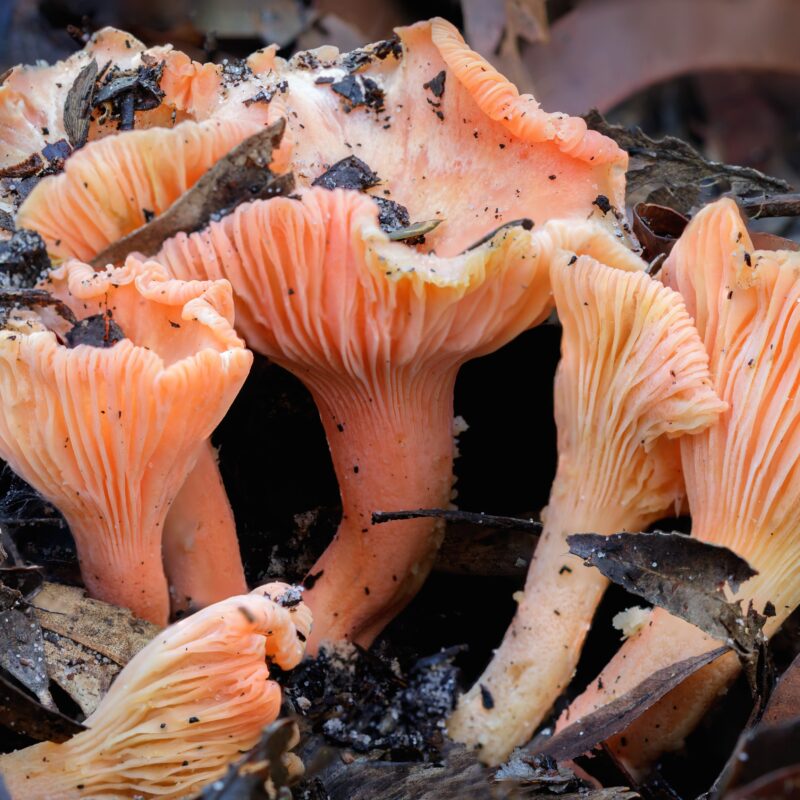
How to make Agar Culture Media?
- Dissolve the malt extract and agar in distilled water.
- Sterilize the solution by autoclaving at 121°C for 15-20 minutes.
- Pour the sterilized media into petri dishes or other containers under sterile conditions.
- The Yeast is optional, but you can add it to any recipe for nutritions, same for Peptone.
Malt Extract Agar
MEA
- 20g malt extract
- 1g peptone (optional)
- 15g agar
- 1L distilled water
Instructions:
Standard Recipe
Yeast Malt Extract Agar
YMEA
- 3g yeast extract
- 3g malt extract
- 5g peptone
- 10g dextrose
- 15g agar
- 1L distilled water
Instructions:
Standard Recipe
Potato Dextrose Agar
PDA
- 200g potatoes (peeled and sliced)
- 20g dextrose (glucose)
- 15g agar
- 1L distilled water
Instructions:
- Boil the potatoes in 500ml of water until soft.
- Strain the potato infusion and discard the solids.
- Add the dextrose and agar to the potato infusion.
- Add more water to make up to 1L.
- Sterilize the mixture by autoclaving at 121°C for 15-20 minutes.
- Pour the sterilized media into petri dishes under sterile conditions.
Oatmeal Agar
OA
- 30g oatmeal
- 1g yeast extract (optional)
- 15g agar
- 1L distilled water
Instructions:
- Boil the oatmeal in 500ml of water.
- Strain the oatmeal infusion and discard the solids.
- Add the yeast extract (if used) and agar to the oatmeal infusion.
- Add more water to make up to 1L.
- Sterilize the mixture by autoclaving at 121°C for 15-20 minutes.
- Pour the sterilized media into petri dishes under sterile conditions.
Fruiting Containers
Plastic Bags
Polypropylene or polyethylene bags are commonly used because they are inexpensive, readily available, and can be easily sealed.
- Advantages: They maintain high humidity levels and allow for easy observation of mycelial growth.
- Usage: Fill the bags with sterilized or pasteurized substrate (like straw, sawdust, or a mix of agricultural waste). Make slits in the bags to allow the mushrooms to fruit through the openings.
Buckets
5-gallon plastic buckets with drilled holes around the sides.
- Advantages: Durable and reusable. The holes allow for good air exchange, which is important for fruiting.
- Usage: Fill the buckets with a sterilized substrate. The mushrooms will fruit through the holes.
Plastic Tubs
Sterilite or similar plastic storage bins with lids.
- Advantages: Provides a controlled environment with good humidity retention. Can be used for larger-scale production.
- Usage: Line the tub with a plastic liner, fill with substrate, and make holes in the liner for the mushrooms to fruit.
Bottles
Plastic or glass bottles with the tops cut off or drilled with holes.
- Advantages: Space-efficient and good for small-scale or experimental grows.
- Usage: Fill the bottles with a sterilized substrate. Mushrooms will fruit from the top or through the holes.
Substrate
- Straw (wheat, rice, oat)
- Sawdust (hardwood, softwood)
- Corn cobs
- Coffee grounds
- Cottonseed hulls
- Sugarcane bagasse
- Paper products (newspaper, cardboard)
- Banana leaves
- Coconut coir
- Logs or stumps (hardwood)
Growing Additives
- Gypsum (calcium sulfate)
- Calcium carbonate (lime)
- Bran (rice, wheat)
- Soybean meal
- Calcium phosphate
- Molasses
- Coffee grounds
- Vermiculite
- Limestone
- Grit (crushed rock)
Biological efficiencie
75-150%
Sometimes we miss a piece
Growing Chracteristics
Mushrooms should be harvested before full maturity, when color and flavor are at their best. This species has a short shelf life after harvest, lasting no more than 3-4 days.
Should not be refrigerated. This tropical species can die if kept below ~8˚c.
Identification
Natrual Habitat
The natural substrate of the Pink Oyster Mushroom is mainly hardwoods such as palm trees, rubber trees and bamboo in the tropics and subtropics, where it is widespread. It decomposes the lignin content of the wood, causing white rot. It relies on relatively high temperatures of 20-30°C, as well as a relative humidity of 95-100% in the air.
Pleurotus djamor is found in the tropics and subtropics of America and Asia. Its range includes South and Latin America, Southeast Asia, Hawaii, Japan, and the Antilles.
In the tropics, subtropics, on palms, rubber trees, bamboo, and grown on deciduous wood at 20-30° Celsius and 95-100% humidity, so it loves warmer regions, post decomposers, triggers white rot, throughout the year.
How to identify Pleurotus djamor
Identifying Pleurotus djamor, commonly known as the Pink Oyster Mushroom, involves several distinctive features. The fruiting bodies typically exhibit vibrant pink to salmon-colored caps that are fan-shaped or semicircular, with a smooth texture and a slightly velvety surface when young. The gills are decurrent, meaning they run down the stem, and are also pinkish. The stems are often short and centrally attached to the cap. Unlike some other oyster mushrooms, P. djamor lacks a distinct anise-like odor. When mature, the caps may fade to pale pink or white. This species prefers warm and humid climates and is often found growing on injured or dead wood, especially in tropical and subtropical regions.
Cap
-2-8 (10) cm Ø
-yellowish to pinkish, light grey, pinkish-red/brown
-velvety
-tomentose
Hymenium
-gills yellowish to pinkish, light grey
-decurrent
-wide
-with intermediate lamellae
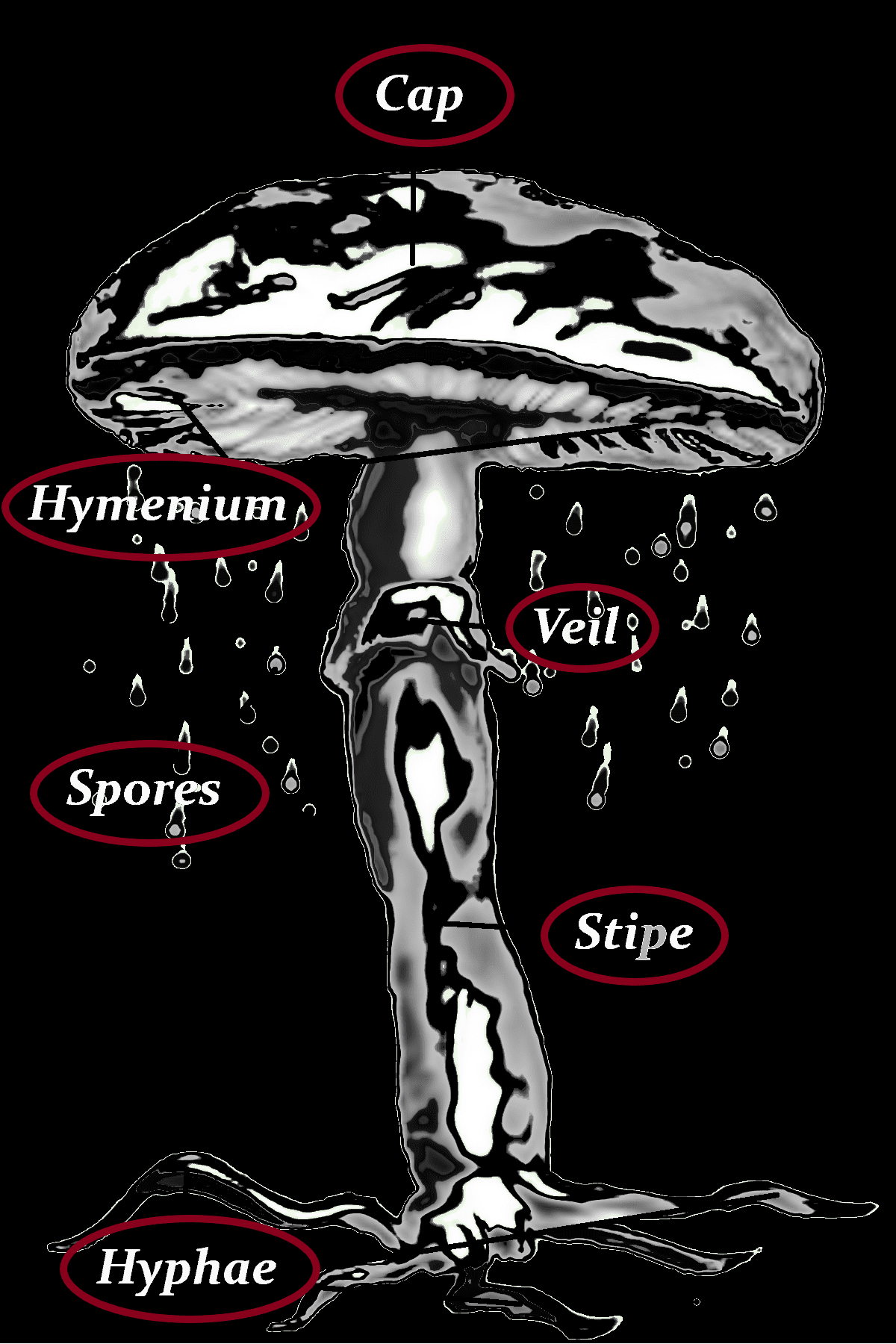
Stipe
-whitish, grey, grey-brown to pinkish, whitish base
Veil
-
Spores
-beige, light brown
-(6-9 x 1.5-3 µm)
Hyphae
reddish
Danger of confusion
Gomphus clavatus, Rhodotus palmatus, Rugosomyces persicolor, Phyllotopsis nidulans, Rhodotus palmatus, Panellus violaceofulvus, Pleurotus pulmonarius, Pleurotus cornucopiae, Pleurocybella porrigens
Consuming
Gorumet Perception
Pleurotus djamor, known as the Pink Oyster Mushroom, holds a significant place in gourmet cuisine due to its appealing taste and unique appearance. Its pink fruiting bodies are not only visually striking but also offer a delicate flavor that is often described as mild and slightly sweet, with a subtle hint of seafood-like umami. This mushroom is particularly favored in East Asian cuisine, where it is valued for its tender texture and ability to absorb flavors when cooked. Chefs appreciate its versatility, using it in various dishes such as stir-fries, soups, risottos, and even as a garnish due to its vibrant color. Beyond its culinary qualities, Pleurotus djamor's popularity is also bolstered by its nutritional benefits, as it is rich in protein, vitamins, and minerals, making it a desirable choice for both gourmet chefs and health-conscious consumers alike. Some say Pleurotus djamor tastes like bacon.
Smell
pungent odour, like nitrate or prussic acid, like almonds
Taste
mild, pleasant
Flesh
white
Here’s how to unlock the true root of Your Brain
– Without worrying about low quality ingredients
Nutritional content of 100g
| Proximates: | |
| Water | 89.2g |
| Energy (Atwater General Factors) | 41kcal |
| Energy (Atwater Specific Factors) | 33kcal |
| Nitrogen | 0.46g |
| Protein | 2.9g |
| Total lipid (fat) | 0.19g |
| Ash | 0.73g |
| Carbohydrates: | |
| Carbohydrate, by difference | 6.94g |
| Minerals: | |
| Calcium, Ca | <2.5mg |
| Iron, Fe | 0.7mg |
| Magnesium, Mg | 13.9mg |
| Phosphorus, P | 86mg |
| Potassium, K | 282mg |
| Sodium, Na | 1mg |
| Zinc, Zn | 0.68mg |
| Copper, Cu | 106mg |
| Manganese, Mn | 86mg |
| Selenium, Se | 1.4µg |
| Vitamins and Other Components: | |
| Thiamin | 0.07mg |
| Riboflavin | 244mg |
| Niacin | 5.75mg |
| Vitamin B-6 | 99mg |
| Biotin | 7µg |
| Folate, total | 63µg |
| Vitamin D (D2 + D3), International Units | 1.6IU |
| Vitamin D (D2 + D3) | 0.04µg |
| Vitamin D2 (ergocalciferol) | 0.04µg |
| Vitamin D4 | 0µg |
| Phytosterols: | |
| Stigmasterol | <0.2mg |
| Campesterol | <0.2mg |
| Beta-sitosterol | <0.2mg |
| Ergosta-7-enol | 1.31mg |
| Ergosta-7,22-dienol | 0.88mg |
| Ergosta-5,7-dienol | 8.43mg |
| Ergosterol | 58mg |
| Beta-sitostanol | <0.2mg |
| Delta-5-avenasterol | <0.2mg |
| Delta-7-Stigmastenol | <0.2mg |
| Amino acids: | |
| Ergothioneine | 14mg |
Composition
Immunostimulating Components
Polysaccharide (β-Glucane)
Known for their immunomodulatory effects, polysaccharides in Pleurotus djamor help strengthen the immune system.
Lectins
Found in oyster mushrooms, lectins may contribute to immune system modulation and antimicrobial activity.
Proteoglykane
Function: Molecules that combine proteins and carbohydrates.
Benefits: They support cell communication and have anti-tumor properties.
Antioxidant Components
Phenolic Compounds
Act as potent antioxidants, scavenging free radicals and reducing oxidative stress.
Flavonoids
Another group of antioxidants that protect cells from damage caused by free radicals.
Fatty Acids
Linoleic Acid
A polyunsaturated omega-6 fatty acid important for maintaining cell membrane structure.
Oleic Acid
A monounsaturated omega-9 fatty acid known for its cardiovascular benefits.
Palmitic Acid
A saturated fatty acid involved in various metabolic processes and cell signaling.
Unique Components
Ergothioneine
An amino acid derivative with antioxidant properties that protects cells from oxidative damage.
Eritadenine
A compound known for its potential cholesterol-lowering effects, unique to mushrooms like P. djamor.
Vitaminreiche Inhaltsstoffe
B Vitamins
Particularly riboflavin (B2), niacin (B3), and pantothenic acid (B5), essential for energy metabolism and overall health.
Vitamin D:
Oyster mushrooms, when exposed to sunlight or UV light, can produce vitamin D, important for bone health and immune function.
Vitamin B12
While in smaller amounts compared to animal products, oyster mushrooms can contain trace amounts of vitamin B12, crucial for nerve function and DNA synthesis.
other names
| Chinesisch (traditionell) | 桃紅側耳 |
| Englisch | Pink Oyster Mushroom |
| Estnisch | roosa servik |
| Japanisch | トキイロヒラタケ |
| Russisch | Вёшенка розовая |
| Spanisch | Girgola Rosa |
| Spanisch | Seta rosa |
| Türkisch | Jamor kayın mantarı |
| Wissenschaftl. Name | Pleurotus djamor |
| Wissenschaftl. Name | Pleurotus scabriusculus |
Rosenroter Seitling, Rosenseitling, Rosaseitling, Rosafarbener Seitling , Pleurotus Djamor (Syn. Pleurotus Salmoneostramineus, Pleurotus Salmoneo-Stramineus, Pleurotus Djamor Var. Roseus, Lentinus Djamor Var. Roseus), Salmon Oysters, Flamingo Oysters, Takiiro Hiratake (Japan)
Taxonomical Hierarchy
| Kingdom | Fungi |
|---|
| Division | Basidiomycota |
| Class | Agaricomycetes |
| Order | Agaricales |
| Family | Pleurotaceae |
| Genus | Pleurotus |
| Species | P. djamor |
| Ecology | Saprotrophic |
Any Sale Helps us Doing what we Love 😊










